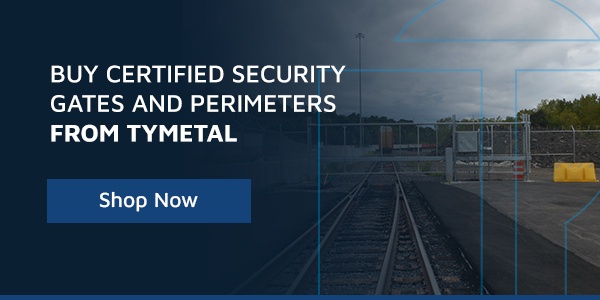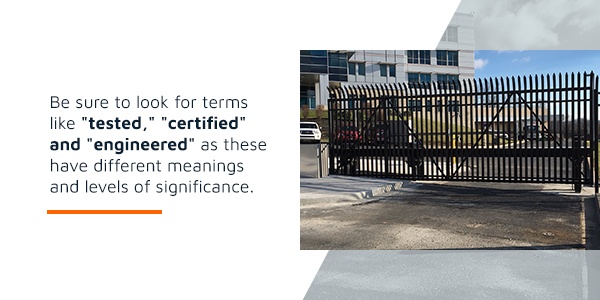### Guide to Understanding Crash Ratings

# Guide to Understanding Crash Ratings
When it comes to securing your property, bollards and security gates play a crucial role in preventing unauthorized access while minimizing potential damage caused by accidents. These barriers are essential for industries and defense facilities alike, ensuring both safety and compliance. But how do you know which barriers are truly effective? This is where standardized crash ratings come into play.
Crash ratings provide a reliable way to evaluate the durability of gates and bollards. They help you determine whether a specific barrier can handle impacts from vehicles effectively. If you're shopping for secure gates or barriers, crash ratings should be your go-to guide. Let's dive into understanding these ratings and what they mean for your security needs.
## Key Factors in Crash Ratings
There are three fundamental factors that determine crash test ratings:
1. **Vehicle Weight**: The heavier the vehicle, the greater the force exerted on the barrier.
2. **Speed**: Higher speeds mean more kinetic energy, making it harder for barriers to withstand impacts.
3. **Distance Beyond Barrier**: How far the vehicle travels after colliding with the barrier is a critical measure of its effectiveness.
Together, these elements form the basis of crash ratings, which can be expressed in either K-ratings or M-ratings. While both systems assess similar criteria, they differ slightly in methodology and application.
## K-Ratings: The Traditional Standard
K-ratings, established by the Department of Defense (DoD), have been around since 1985. These ratings are based on the performance of a 15,000-pound vehicle crashing into a barrier at various speeds. For a K-rating to be valid, the vehicle must not travel more than 50 feet beyond the barrier.
Here’s a breakdown of common K-ratings:
- **K4 Rating**: Vehicle travels no more than 50 feet beyond the barrier at 30 mph.
- **K8 Rating**: Vehicle travels no more than 50 feet beyond the barrier at 40 mph.
- **K12 Rating**: Vehicle travels no more than 50 feet beyond the barrier at 50 mph.
Additionally, K-ratings are further categorized into L1, L2, and L3 levels based on how far the front of the vehicle penetrates the barrier:
- **L3**: Less than 3 feet beyond the barrier.
- **L2**: Between 3 and 20 feet beyond the barrier.
- **L1**: Between 20 and 50 feet beyond the barrier.
The highest K-rating, K12:L3, indicates that a 15,000-pound vehicle moving at 50 mph barely penetrates the barrier.
## M-Ratings: The Modern Approach
In recent years, M-ratings have become the preferred standard, thanks to guidelines set by the American Society for Testing and Materials (ASTM). Unlike K-ratings, M-ratings focus on the distance the vehicle's payload travels beyond the barrier rather than its front. This approach provides a more precise measurement of a barrier's effectiveness.
M-ratings correspond directly with K-ratings in terms of vehicle speed:
- **M30 Rating** = **K4 Rating** (30 mph)
- **M40 Rating** = **K8 Rating** (40 mph)
- **M50 Rating** = **K12 Rating** (50 mph)
Furthermore, M-ratings are classified into four categories based on how far the vehicle travels beyond the barrier:
- **P1**: No more than 3.3 feet.
- **P2**: Between 3.31 and 23 feet.
- **P3**: Between 23.1 and 98.4 feet.
- **P4**: Greater than 98.4 feet.
An M50:P1 rating, for example, signifies that a 15,000-pound vehicle moving at 50 mph doesn’t travel more than 3.3 feet beyond the barrier.
## Understanding Labels: Tested, Certified, or Engineered?
When evaluating crash-rated barriers, it’s important to differentiate between terms like "tested," "certified," and "engineered." Here's what each term really means:
- **Tested**: A product labeled "tested" simply means it underwent testing. However, passing the test isn’t guaranteed, so proceed with caution.
- **Certified**: A "certified" label ensures the product passed the specified test and meets the required rating. Always opt for certified products.
- **Engineered**: Products labeled "engineered" are designed to meet certain standards but may not have undergone real-world testing. Ask vendors if engineered products were physically tested before purchasing.
To ensure reliability, always look for certified M-ratings and K-ratings.
## Decoding ASTM Models and Codes
ASTM employs specific models and codes to classify anti-ram barriers based on vehicle speed, weight, and distance traveled. Familiarizing yourself with these codes will enhance your understanding of crash ratings. Key elements include:
- **S10, S20, S30**: Minimum test velocities of 10, 20, and 30 mph, respectively.
- **P1, P2, P3**: Penetration ratings indicating how far the vehicle traveled beyond the barrier.
Low-speed tests are stricter, allowing no more than 1 foot of penetration for a P1 rating. High-speed tests are more lenient, permitting up to 3.3 feet for a P1 rating.
## Shop Certified Security Gates and Perimeters
At TYMETAL, we pride ourselves on offering certified security gates and crash barriers that meet stringent ASTM standards. Rest assured knowing our products have been rigorously tested and proven to withstand real-world scenarios.

When it comes to protecting your property, trust only the best. Explore our range of certified security solutions today!
---
Reviewed By Chris Herold on 4/29/2021
### Share:

**Share:**
[Facebook] [Twitter] [LinkedIn]
---
### Latest TYMETAL News
#### How the Chemical Industry is Bolstering Security Post-CFATS Expiration
Seán Ottewell, Editor-at-Large of *Chemical Processing*, recently published an article about how the chemical industry is adapting to enhanced security measures following the expiration of CFATS regulations. Learn more about the innovative strategies being implemented across the sector.
[Read More](http://bsg-i.nbxc.com/blog/90d1fa50d5e6023f96fb4e68464937c9.jpg)
#### Choosing the Right Security Gate for Your Industrial Facility
In a world where cybersecurity dominates headlines, it’s easy to overlook the importance of physical security. Discover key factors to consider when selecting the perfect gate for your industrial facility.
[Read More](http://bsg-i.nbxc.com/blog/82da7f5c0512fa555d966005d28c62b4.jpg)
#### Meet the TYMETAL Team at GSX 2024
Join us at the Global Security Exchange (GSX) 2024 as we showcase cutting-edge security solutions for professionals worldwide.
[Read More](http://bsg-i.nbxc.com/blog/adba9ba12ef7a8a210c4d4bb1defcfea.jpg)
Chrome Twin Screw Extruder,Screw Plastic Extruder,Twin Screw Cylinders
ZHEJIANG BOHAI MACHINERY CO., LTD , https://www.bohai-screw.com
